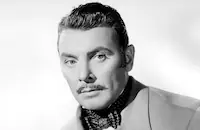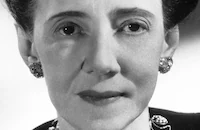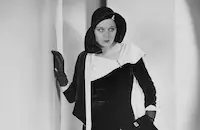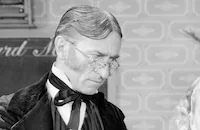So Big

Brief Synopsis
Cast & Crew
William A. Wellman
Barbara Stanwyck
George Brent
Dickie Moore
Bette Davis
Mae Madison
Film Details
Technical Specs

Synopsis
After her mother dies, Selina Peake's father takes her to Chicago, where she attends a finishing school. When her father is killed, leaving her penniless, Selina's friends learn that he was a gambler and drop her. Only Julie Hemple helps her, persuading her father, August Hemple, to get Selina a job as a schoolteacher in a small Dutch community near Chicago. There, Selina lives with a farm family, helping their adoring son Roelf with his lessons. Eventually, she marries farmer Pervus De Jong and gives birth to a son, Dirk, who becomes the center of all her hopes and dreams. As he grows, she measures him daily and nicknames him "So Big." Pervus dies, leaving Selina the struggling farm. Determined, she makes the farm pay, which enables Dirk to go away to school and eventually establish himself as an architect. Over the years, everyone comes to love the hardworking, idealistic Selina. Dirk, however, does not have his mother's strength. He falls in love with a married woman who persuades her husband to give him a job as a bond salesman in his office. He is embarrassed by his mother's farm, even though her excellent asparagus paid for his education. When he falls in love with Dallas O'Mara, a talented artist, she refuses to marry him because he is unwilling to work at something worth while. Meanwhile, Roelf has become a great sculptor. He meets Dirk, and learning that he is Selina's son, asks to see her again. At the meeting, Selina compares Roelf and Dirk, acknowledging her son's faults, while at the same time, rejoicing in Roelf's talent and good character.

Director

William A. Wellman
Cast

Barbara Stanwyck

George Brent

Dickie Moore

Bette Davis

Mae Madison

Hardie Albright

Alan Hale
Earle Fox

Robert Warwick

Dorothy Peterson

Noel Francis
Dick Winslow

Guy Kibbee
Arthur Stone

Dawn O'day
Harry Beresford
Eulalie Jensen

Elizabeth Patterson

Rita La Roy
Blanche Frederici
Willard Robertson
Martha Mattox
Emma Ray

Olin Howland
Andre Cheron
Harry Holman
Lionel Belmore
Crew
J. Grubb Alexander
Wesley Anderson
Leo F. Forbstein
Sid Hickox
William Holmes
Robert Lee
Robert Lord
Earl Luick
Jack Okey
Richard Towers
William Walling Jr.

Videos
Movie Clip



Trailer
Film Details
Technical Specs

Articles
So Big (1932)
The novel had been made into a silent film in 1924, starring Colleen Moore. It was remade as a short in 1930, with Helen Jerome Eddy. (A fourth version starring Jane Wyman would be made in 1953.) The 1932 version starred Barbara Stanwyck, who had arrived in Hollywood from Broadway in the early days of sound, signed a contract with Warner Bros., and was already one of the busiest and most respected of the younger actresses. She had made films with such well-regarded directors as Frank Capra and William Wellman, and the latter would also direct So Big. Wellman, known as "Wild Bill," was a veteran World War I flyer, a rip-roaring "man's man," and director of robust adventure films. Working with him was not for the faint of heart, but he and the Brooklyn-born Stanwyck (who was outspoken, a "man's woman," and a fearless actress) got along well and made a total of five films together.
Playing a supporting role in So Big was another recent Broadway émigré and Warner Bros. contract player, Bette Davis. She was about the same age as Stanwyck, but had not yet achieved leading lady status. In So Big, she showed up near the end of the film, playing the girlfriend of Selina's son. In her autobiography, Davis writes that being cast in a Stanwyck film meant that the studio was recognizing her work. "It was a source of tremendous satisfaction, and encouraged me to unheard-of dreams of glory." But according to other sources, the two women did not get along. Wellman later told an interviewer that Davis "was jealous because a contemporary had achieved stardom quickly while she had to grind through small roles and bad pictures." Wellman recalled that Stanwyck felt Davis used her mannerisms and fidgeting to draw attention to herself. When a nervous Davis blew her lines, Stanwyck not only showed no sympathy, she scolded her publicly. Years later, Stanwyck minced no words about Davis with biographer Lawrence J. Quirk. "She was always so ambitious, you knew she'd make it. She had a kind of creative ruthlessness that made her success inevitable."
So Big was the first time Davis worked with George Brent, who would become one of her favorite and most frequent co-stars. Brent was born in Ireland and immigrated to the U.S. at age 11, after his parents' deaths. At 17, he returned to Ireland and got some small roles at Dublin's Abbey Theatre. He also joined the Irish Republican Army in their subversive activities against the British. Pursued by the British army, Brent was smuggled back to America, eventually ending up on Broadway, and going to Hollywood in 1931. He and Davis would appear in 11 films together. They had an on-and-off affair for several years, and always spoke fondly of each other.
As for So Big, most critics felt there was too much story to tell adequately in the film's brief running time. According to Variety, "Wellman's endeavor at kaleidoscopic flashes in the life of Selina Dejong...make for a choppy continuity....as it is, the 83 minutes are overly long, but in toto, it's a disjointed affair." However, both Stanwyck and Davis earned praise for their performances. The New Yorker critic wrote, "in her impersonation of the American farmer's wife, Barbara Stanwyck does the best work she has yet shown us." The New York Mirror critic gushed, " Barbara Stanwyck is exquisite....Her great talent as an actress never has been demonstrated more brilliantly. A sparkling performance. She is magnificent." And Andre Sennwald wrote in the New York Times, "Bette Davis, as the young artist who sees into the complicated story of Selina's life, is unusually competent." By the mid-1930s, Davis had caught up with Stanwyck, thanks to the success of such films as Of Human Bondage (1934), and by the end of the decade, she had two Oscars® and was Warner Bros.' top star. As Stanwyck predicted, Davis' success had been inevitable.
Director: William A. Wellman
Producer: Lucien Hubbard
Screenplay: J. Grubb Alexander, Robert Lord, based on the novel by Edna Ferber
Cinematography: Sid Hickox
Editor: William Holmes
Costume Design: Orry-Kelly
Art Direction: Jack Okey
Music: W. Franke Harling
Principal Cast: Barbara Stanwyck (Selina Peake Dejong), George Brent (Roelf Pool), Dickie Moore (Dirk Dejong as a boy).
BW-81m.
by Margarita Landazuri

So Big (1932)
Quotes
Trivia
Notes
Edna Ferber's novel won the Pulitzer Prize. According to Film Daily, Joseph Jackson wrote the adaptation with J. Grubb Alexander. The exact nature of his contribution to the final film has not been determined. Ferber's story was first filmed in 1924 by First National with star Colleen Moore, (see AFI Catalog of Feature Films, 1921-30; F2.5201). Warner Bros. remade the novel in 1953 with Jane Wyman as Selina. That version was directed by Robert Wise.















